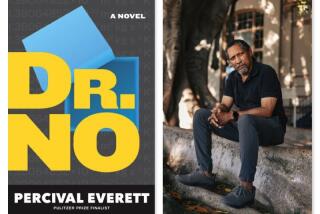Environmentalist Charles Bowden Chipping Away at ‘Cement Heads’
As Charles Bowden sees things, the “cement heads” want to turn this Sun Belt boomtown into another Phoenix, or, even worse, another Los Angeles.
Tucson resident Dave Foreman, founder of the radical environmental group Earth First!, calls Bowden the author most likely to carry the torch of militant ecology that was ignited by Tucson author Edward Abbey. Abbey himself thinks Bowden has a lot of potential, if he would just tear himself away from “that silly magazine.”
But Bowden likes his magazine. Although his books--”Killing the Hidden Waters,” “Frog Mountain Blues,” and “Blue Desert”--are important works of what might be called “the new naturalism,” when he decided last year to create and edit a publication, he called it City Magazine.
Tucson, you see, is a 98.8-square-mile section of the Sonoran desert. It also happens to be a city. So the city is where Bowden will make his stand.
With a population of about 600,000 and growing, greater Tucson is already a scab of strip malls, mini-storage units, condo projects and tacky trailer courts spreading across the dry skin of the desert. But Bowden believes that if the “cement heads” can be stopped, or at least restrained here, there’s a chance Tucson will show the rest of the West a way out of the mire of water pollution and depletion, smog, gridlock, urban blight and crime into which it seems destined to sink.
“The action is here . . . the future is being invented here now,” he said.
In one room of City Magazine’s offices, Bowden’s young staff blasts Dead Kennedy’s agit-punk as they lay out the next issue of the slick Interview magazine-sized publication. The centerpiece of Bowden’s office is an Apple MacIntosh that plays the “Twilight Zone” theme when he turns it on. An eclectic library clutters bookshelves topped with bottles of Canadian Club whiskey and mescal. Bowden seems like the kind of guy who eats the worm.
But he settled reluctantly for rose wine when a little Thai restaurant on Tucson’s sign-spangled Speedway Boulevard (which Life magazine once proclaimed “the ugliest street in the country”) couldn’t find a bottle of burgundy. Between forkfuls of green curry shrimp hot enough to compete with the area’s more indigenous chile dishes, Bowden spoke in a voice not evident in his books.
In his books, Bowden is often angry, often pained.
But Bowden the editor and publisher says he can’t embrace the “No Compromise in Defense of Mother Earth!” slogan of Earth First!’s angry and pained environmentalists.
“This city’s going to be built. It’s being built fast,” he said. “The only question is whether it will be built willy-nilly, helter skelter, or built with certain plans, values and guidelines. Twenty years from now, whether it’s ugly or beautiful, functional or disfunctional, we’ll have to live with it.
“What you can’t do is save the city of 125,000 I was raised in. What you can do is preserve some values. . . . There’s a war going on between people like me and people with cement trucks.”
‘Scream Against Freeways’
To hold off the forces of “progress,” a cadre of people in Tucson has fought to provide environmental zones around roadways and through the arroyos that transect the city so that bobcats and coyotes and lizards and owls will survive. They dog developers to make sure sewer permits are properly filed. And “refugees” from California get up at planning commission meetings and “scream against freeways.”
“You make it expensive for the cement heads to operate,” Bowden said. “Right now, we’ve stalemated each other.”
The one thing Bowden won’t do, however, is dismiss his critics. “I live in a community with other people. The fact of the matter is, we’re going to all have to sit down.”
“I hate this elitism in conservation in the U.S. since the 19th Century. This sort of nature writing of ‘We the sophisticated, the sensitive, can save the Hudson Valley and Yosemite from the great unwashed.’
“My vision of hell would be to go into a bar where everyone thought the same way as I do.” So he created City Magazine as a sort of sparring ring, “where developers and environmentalists can yell at each other.”
‘Orchestrates Voices’
City Magazine has no editorial position on growth and development, Bowden said. As managing editor he “just orchestrates voices.” He lets everyone have their best shot, he says. “We’re printing the most honest stuff in this city about developers, and I mean from their point of view. . . . I have one of the biggest developers in this city in the same issue as Ed Abbey--cheek by jowl.”
In “Blue Mountain,” Bowden writes of reading a wildlife book when he was a boy. “Outside the library window, traffic crawls down 79th Street under a gray Chicago sky. In my hand, the moose feeds and there is no sound and no sign of city.
“I have spent my life trying to cross from that street into that page, trying to escape into that bog,” he writes.
As Bowden’s magazine attests, however, city life with its food and drink and music, bookstores, jobs, and films, is hardly something this Chicago-born man of 42 can pretend to disdain. And Bowden knows that in embracing parts of civilization, he also embraces a paradox. The wild ground, he writes, is not just threatened by the “various bogey men of my time--the capitalists, the zany urban throngs . . . the deadened minds of wage slaves, businessmen, greed fiends . . . stockbrokers, real estate developers, lawyers, gangsters, travel agents and used car salesmen. It is threatened by me.”
At the same time, though, he doubts that a city dweller who lacks access to the wilds can maintain much sanity.
‘People Need That Release’
“I don’t think you’ve got to be Thoreau and talk to trees. But people need that release. . . . I don’t know a single human who’s taken a boat ride down the Grand Canyon who hasn’t been changed, who hasn’t gotten in touch with something deep in themselves that informed them the rest of their lives,” he said.
A few nights earlier, Bowden had interviewed a developer from Phoenix who is building a large housing development at the foot of the nearby Santa Catalina mountains. The area is particularly rich in wildlife, and Bowden asked the man if he were using that fact to attract home buyers.
“He said, ‘I can’t sell coyotes,’ ” Bowden recalls. “But he’s dead wrong.”
People want to know that they’re living close to the mythical frontier that holds such a hallowed place in the American psyche. They want to hear that wild howl in the night, Bowden believes.
The developer is “a nice guy,” he says. “But he’s a person who hasn’t been in the Grand Canyon.”
A Pie-in-the-Sky Project?
Bowden has been in the Canyon, but his most ambitious, and possibly most pie-in-the-sky project, concerns a mountain range.
“I can no longer trust that wild ground will survive through some kind of benign neglect. We need rules, rules that toss us out of such places,” he writes in “Frog Mountain Blues.” And Bowden wants someone to write some rules that will return the Santa Catalina mountains that are Tucson’s most striking piece of scenic landmark, to their natural state. He wants to pull out the highway, the cabins, and the ski lodge.
“If Frog Mountain can be saved, the city will always have one thing that we cannot create ourselves,” he writes. “A place that mocks the safe limits of our own imagination. A place that does not obey.”
City-slick City Magazine shows that Bowden maintains gritty city instincts for stories on crime and politics. But November’s first anniversary issue, titled “Our Town,” depicts a backlighted saguaro cactus, and words that a reader might at first suspect were the work of some schmaltzy chamber of commerce flack:
You remember the day you arrived.
Those first few hours, the town looks harsh
and dusty. The sun seems too bright.
But the mountains make you stay. . . .
More to Read
Sign up for our Book Club newsletter
Get the latest news, events and more from the Los Angeles Times Book Club, and help us get L.A. reading and talking.
You may occasionally receive promotional content from the Los Angeles Times.






